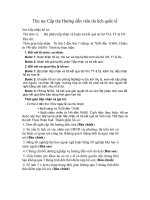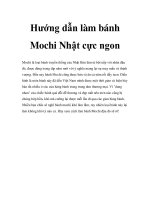Cập nhật hướng dẫn Surviving sepsis
Bạn đang xem bản rút gọn của tài liệu. Xem và tải ngay bản đầy đủ của tài liệu tại đây (347.22 KB, 26 trang )
<span class='text_page_counter'>(1)</span><div class='page_container' data-page=1></div>
<span class='text_page_counter'>(2)</span><div class='page_container' data-page=2>
Aim
● Discuss various components of the Surviving Sepsis
Guidelines
● Appraise evidence briefly
● Discuss critiques of the guidelines
● Identify strategies to apply guidelines with equipoise in
</div>
<span class='text_page_counter'>(3)</span><div class='page_container' data-page=3>
Review of the 2018 update
</div>
<span class='text_page_counter'>(4)</span><div class='page_container' data-page=4>
Definitions have changed
●
<i><b>Seps is</b></i>
: Life-threatening organ dysfunction
caused by dysregulated host response to
infection
●
<i><b>Septic Shock</b></i>
: Subset of sepsis with
circulatory and cellular/metabolic
dysfunction associated with higher risk of
mortality
</div>
<span class='text_page_counter'>(5)</span><div class='page_container' data-page=5>
Clinical criteria (SEP-3 vs SIRS)
SEP 3 definitions using qSOFA are not incorporated in the
guidelines.
Suggest use of qSOFA in place of SIRS criteria
</div>
<span class='text_page_counter'>(6)</span><div class='page_container' data-page=6>
1 hour bundle
● Measure lactate level. (repeat later if high)
● Obtain blood cultures before administering antibiotics.
● Administer broad-spectrum antibiotics.
● Begin rapid administration of 30mL/kg crystalloid for
hypotension or lactate ≥4 mmol/L.
</div>
<span class='text_page_counter'>(7)</span><div class='page_container' data-page=7>
Resuscitation: Changes from 2012
3 and 6 hour bundles no longer endorsed.
Dynamic indices of perfusion prefered over static numbers.
More focus on acting quickly and monitoring response.
</div>
<span class='text_page_counter'>(8)</span><div class='page_container' data-page=8>
Critiques
30 ml/kg in 3 hours is a very high fluid load. Potentially
dangerous in multiple clinical settings.
Quality of evidence is low to moderate but recommendations
are classified as “Strong”.
</div>
<span class='text_page_counter'>(9)</span><div class='page_container' data-page=9>
Antibiotics and Source control
● Anatomic site for source control be identified/excluded
ASAP
● Antimicrobials be initiated as soon as possible after
recognition and within 1 h for both sepsis and septic shock.
● Empiric broad-spectrum therapy with one or more
antimicrobials to cover all likely pathogens. Get cultures if
no major delay.
● De-escalation is encouraged as soon as feasible. Shorter
courses recommended.
</div>
<span class='text_page_counter'>(10)</span><div class='page_container' data-page=10>
Problems...
● No definite study to prove that short delays in antibiotics
worsens mortality. Time to intervention studies are hard to
replicate.
● IDSA has NOT endorsed the 1 hour window, procalcitonin
use, double coverage and days of antibiotics.
● Attempt to focus on disease specific combination therapy
</div>
<span class='text_page_counter'>(11)</span><div class='page_container' data-page=11>
Fluids
Use crystalloids and avoid colloids.
Use dynamic indices and fluid challenges to assess
responsiveness.
Differentiate responsiveness from need for fluid.
Suggest albumin if crystalloid amount used is high.
</div>
<span class='text_page_counter'>(12)</span><div class='page_container' data-page=12>
Practical issues
● For the developing world mentioning albumin in a guideline
is a concern.
● ALBIOS and SAFE trials don't show a major benefit for
albumin. Glycocalyx based models suggest no benefit.
● Not all dynamic indices are equal. Ultrasound based (aortic
doppler, IVC) or PLR based methods are attractive but have
their flaws.
</div>
<span class='text_page_counter'>(13)</span><div class='page_container' data-page=13>
Vasopressors
Norepinephrine is first choice, target a MAP of 65 mmHg.
Epinephrine and vasopressin (fixed dose) may be added
(sequentially)
Dopamine in highly selected cases only - renal perfusion is not a
good indication.
Suggest use of arterial catheters
</div>
<span class='text_page_counter'>(14)</span><div class='page_container' data-page=14>
Concerns
● Sequential pressors may not always be good. May lead to
very high levels of one agent.
● Epinephrine may raise lactate - but that may be a good
thing.
● Arterial catheters may not be necessary and probably
should not be mandated. The quality of evidence was
</div>
<span class='text_page_counter'>(15)</span><div class='page_container' data-page=15>
Steroids
Suggest adding if fluids and pressors are not able to restore
stability.
Hydrocortisone 200 mg per day (continuous infusion)
Recommend against ACTH stim test.
</div>
<span class='text_page_counter'>(16)</span><div class='page_container' data-page=16>
Insights
Recent trial (ADRENAL) with hydrocortisone showed no
difference in mortality.
The APROCCHSS study showed benefit mortality with
fludrocortisone + hydrocortisone.
</div>
<span class='text_page_counter'>(17)</span><div class='page_container' data-page=17>
Blood sugars
● Protocolized management.
● Keep levels below 180
● Monitor every 1-2 hrs initially
</div>
<span class='text_page_counter'>(18)</span><div class='page_container' data-page=18>
Blood products
● Transfusion trigger is 7.0 mg/dl
● Avoid erythropoetin
● Avoid FFP to correct lab abnormalities in the absence of
bleeding.
● Platelet transfusion trigger is <10,000/mm^3 in the absence
</div>
<span class='text_page_counter'>(19)</span><div class='page_container' data-page=19>
Mechanical Ventilation
● TV 6 ml/kg and early proning for severe cases.
● Suggest high rather than low PEEP
● No recommendation on NIV
● Suggest recruitment maneuvers
● Early NMBA for <48 hrs is ok
● Avoid beta 2 agonists (if bronchospasm is absent), PA
catheters.
</div>
<span class='text_page_counter'>(20)</span><div class='page_container' data-page=20>
● Use weaning protocols, spontaneous breathing trials and
conservative fluid strategies.
● Elevate head end by 30-45 degrees for VAP prevention.
</div>
<span class='text_page_counter'>(21)</span><div class='page_container' data-page=21>
Renal
If pH is above 7.15 avoid bicarbonate therapy.
Either continuous or intermittent is acceptable.
Oliguria and creatinine elevation are not good indication.
CRRT may be preferred in unstable patients.
</div>
<span class='text_page_counter'>(22)</span><div class='page_container' data-page=22>
Nutrition
Avoid early parenteral nutrition if enteral feeding is possible.
Early trophic feeding is acceptable. Parenteral nutrition is not
needed in the first 7 days.
Arginine/Omega 3 FA, glutamine, selenium are not
recommended.
</div>
<span class='text_page_counter'>(23)</span><div class='page_container' data-page=23>
VTE and Stress ulcer prophylaxis
● Use pharmacological means.
● LMWH is preferred.
● Combined mechanical and pharmacological is suggested.
(weak evidence)
● Give SUP for patients at risk. Avoid if no risk factors are
present.
● PPI or H2B suggested.
</div>
<span class='text_page_counter'>(24)</span><div class='page_container' data-page=24>
Comments
● Evidence for SUP and VTE is changing.
● SUP ICU (Nejm 2018) was a negative study for SUP in the ICU
● If nutrition and supportive care has improved then it is likely
</div>
<span class='text_page_counter'>(25)</span><div class='page_container' data-page=25>
Goals of care
● Address goals of care as early as possible.
● Discuss prognosis with patients and family
● Integrate goals of care into end of life care plan and
palliative care.
</div>
<span class='text_page_counter'>(26)</span><div class='page_container' data-page=26>
References
1. Jones, Alan E et al. “Lactate clearance vs central venous oxygen saturation as goals of early sepsis therapy: a randomized
clinical trial” JAMAvol. 303,8 (2010): 739-46.
2. Singer M, Deutschman CS, Seymour CW, et al. The Third International Consensus Definitions for Sepsis and Septic Shock
(Sepsis-3). <i>JAMA</i>. 2016;315(8):801-10.
3. Rhodes A, et al. Surviving Sepsis Campaign: International Guidelines for Management of Sepsis and Septic Shock: 2016.
Intensive Care Med. 2017
4. Pepper DJ,et al. Evidence Underpinning the Centers for Medicare & Medicaid Services' Severe Sepsis and Septic Shock
Management Bundle (SEP-1): A Systematic Review. Ann Intern Med.
5. Gore DC, Jahoor F, Hibbert JM, DeMaria EJ. Lactic acidosis during sepsis is related to increased pyruvate production, not
deficits in tissue oxygen availability. <i>Ann Surg</i>. 1996;224(1):97-102.
6. Does Central Venous Pressure Predict Fluid Responsiveness?*: A Systematic Review of the Literature and the Tale of
Seven Mares Marik, Paul E. et al. CHEST , Volume 134
7. Sterling SA, Miller WR, Pryor J, Puskarich MA, Jones AE. The Impact of Timing of Antibiotics on Outcomes in Severe Sepsis
and Septic Shock: A Systematic Review and Meta-Analysis. <i>Crit Care Med</i>. 2015;43(9):1907-15.
</div>
<!--links-->









